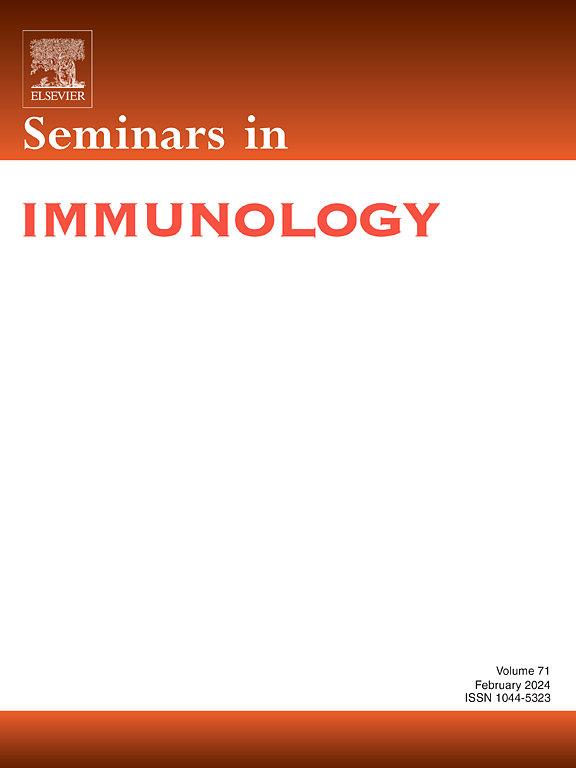免疫检查点抑制剂治疗后神经免疫相关不良事件的发病机制
IF 7.4
2区 医学
Q1 IMMUNOLOGY
引用次数: 0
摘要
癌症是全世界发病率和死亡率的主要原因。免疫检查点抑制剂(ICI)的发展彻底改变了癌症治疗,以前无法治愈的患者现在可以有很好的反应。这些疗法通过阻断抑制免疫途径发挥作用,如细胞毒性T淋巴细胞相关蛋白4 (CTLA-4)、程序性细胞死亡1 (PD-1)、其配体PD-L1和淋巴细胞激活基因3 (LAG-3);从而增加抗肿瘤免疫反应。然而,它们的使用可能导致免疫相关不良事件(irAEs)的发生,这可能导致严重的残疾,中断癌症治疗,甚至死亡。1 - 10%的患者会出现神经系统自身免疫后遗症,并且可能是致命的。它们涵盖了广泛的疾病,可能影响中枢和周围神经系统,包括脑炎、小脑炎、神经病变和肌炎等综合征。在某些情况下,神经irae可与识别神经元或神经胶质靶点的自身抗体相关联。在这篇综述中,我们首先描述了ICI治疗的关键靶点,然后是irae的配方及其临床表现,其中我们重点关注神经系统综合征。我们综合制定了当前的文献评估细胞表面和细胞内自身抗体,细胞因子,趋化因子,白细胞模式,其他血液来源的生物标志物,和免疫遗传谱;并强调它们对我们理解神经系统irae发病机制的影响。最后,我们描述了治疗途径和患者结果,并概述了ICI癌症治疗的未来方面。本文章由计算机程序翻译,如有差异,请以英文原文为准。
The pathogenesis of neurological immune-related adverse events following immune checkpoint inhibitor therapy
Cancer is a leading cause of morbidity and mortality worldwide. The development of immune checkpoint inhibitors (ICI) has revolutionised cancer therapy, and patients who were previously incurable can now have excellent responses. These therapies work by blocking inhibitory immune pathways, like cytotoxic T lymphocyte-associated protein 4 (CTLA-4), programmed cell death-1 (PD-1), its ligand PD-L1, and lymphocyte activation gene 3 (LAG-3); which leads to increased anti-tumour immune responses. However, their use can lead to the development of immune-related adverse events (irAEs), which may result in severe disability, interruption of cancer therapy, and even death. Neurological autoimmune sequelae occur in 1–10 % of patients treated with ICIs and can be fatal. They encompass a broad spectrum of diseases, may affect the central and the peripheral nervous system, and include syndromes like encephalitis, cerebellitis, neuropathy, and myositis. In some cases, neurological irAEs can be associated with autoantibodies recognising neuronal or glial targets. In this review, we first describe the key targets in ICI therapy, followed by a formulation of irAEs and their clinical presentations, where we focus on neurological syndromes. We comprehensively formulate the current literature evaluating cell surface and intracellular autoantibodies, cytokines, chemokines, leukocyte patterns, other blood derived biomarkers, and immunogenetic profiles; and highlight their impact on our understanding of the pathogenesis of neurological irAEs. Finally, we describe therapeutic pathways and patient outcomes, and provide an overview on future aspects of ICI cancer therapy.
求助全文
通过发布文献求助,成功后即可免费获取论文全文。
去求助
来源期刊

Seminars in Immunology
医学-免疫学
CiteScore
11.40
自引率
1.30%
发文量
50
审稿时长
89 days
期刊介绍:
Seminars in Immunology is a specialized review journal that serves as a valuable resource for scientists in the field of immunology. The journal's approach is thematic, with each issue dedicated to a specific topic of significant interest to immunologists. It covers a wide range of research areas, from the molecular and cellular foundations of the immune response to the potential for its manipulation, highlighting recent advancements in these areas.
Each thematic issue is curated by a guest editor, who is recognized as an expert in the field internationally. The content of each issue typically includes six to eight authoritative invited reviews, which delve into various aspects of the chosen topic. The goal of these reviews is to provide a comprehensive, coherent, and engaging overview of the subject matter, ensuring that the information is presented in a timely manner to maintain its relevance.
The journal's commitment to quality and timeliness is further supported by its inclusion in the Scopus database, which is a leading abstract and citation database of peer-reviewed literature. Being indexed in Scopus helps to ensure that the journal's content is accessible to a broad audience of researchers and professionals in immunology and related fields.
 求助内容:
求助内容: 应助结果提醒方式:
应助结果提醒方式:


